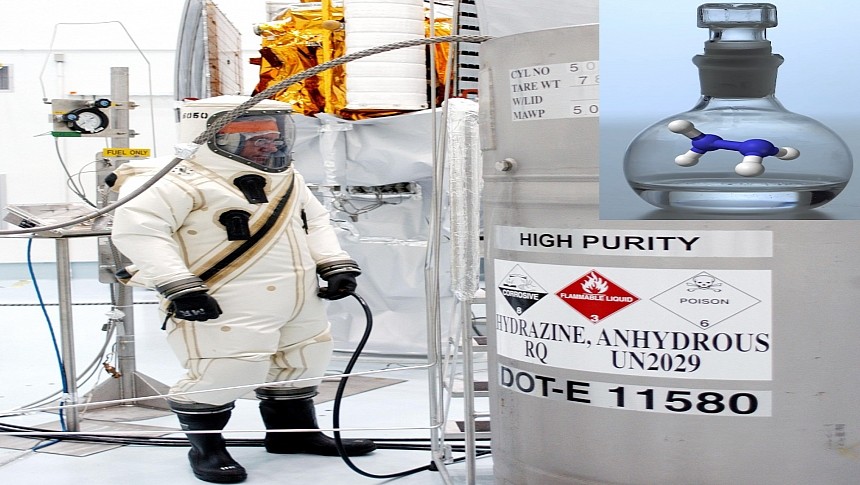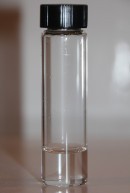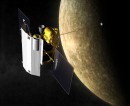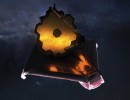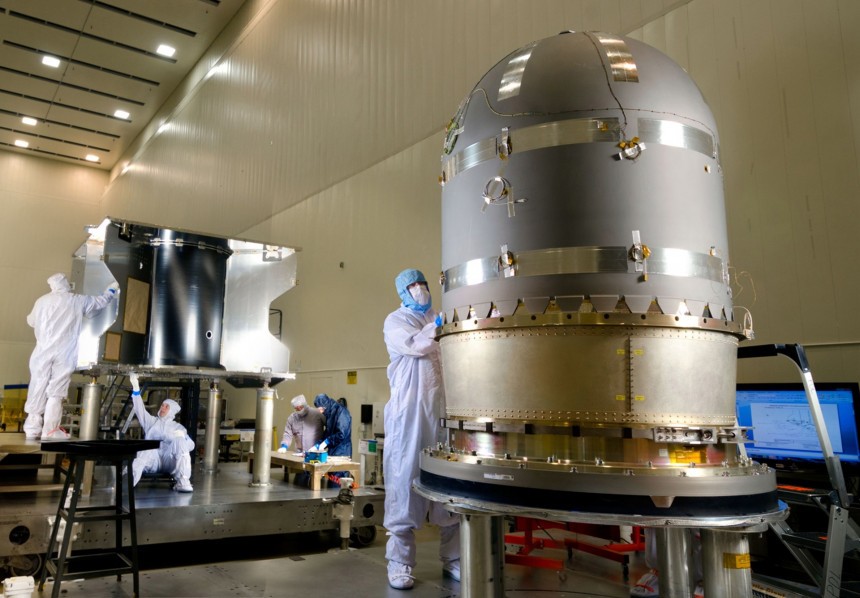Chemical fuel is nasty stuff to squishy, vulnerable flesh sacks called humans, from the noxious, flammable vapor of gasoline to the pungent stench of diesel that permeates for hundreds of yards in either direction. There are so many ways and more everyday combustible fuel can ruin your day. But if you're a NASA astronaut servicing a satellite high up in low-Earth orbit, there's a chance you'll come in contact with a chemical fuel that makes gasoline look like water and diesel look like spicy iced tea.
This is hydrazine, and it's the toxic, carcinogenic, potentially explosive chemical concoction powering satellites across the globe and beyond. At its core, hydrazine is just another inorganic, man-made compound consisting of two internal bonded nitrogen atoms flanked on either side by four hydrogen atoms. When stored inside glass vials or ampules, hydrazine takes the state of a clear liquid. Only when you remove the top does its noxious fumes make themselves apparent.
Should someone not be thoroughly trained in safe chemical handling procedures come in contact with it, hydrazine has more than a few ways of wreaking havoc. If you get any on your skin, rashes and full-on chemical burns are soon to follow. Handle it without a respirator, and you're liable to be thrown into a simultaneous coughing and vomiting fit as if you're in the middle of a First World War gas attack. Hang around hydrazine over a long enough period without proper protection, and there's a marginal but equally terrifying possibility of developing lung cancer.
Improper disposal of hydrazine is linked to its own set of hazards altogether. Though it breaks down fairly rapidly when exposed to high concentrations of oxygen, research by the U.S. Center for Disease Control finds hydrazine can still infiltrate surrounding ecosystems if living creatures come into contact with it before it's decayed into less potent compounds.
Accelerated deaths of fish in rivers, streams, and ponds around hydrazine production plants and disposal areas have been observed in known exposure sites. However, the full extent of its concentration in each fish by the time it's potentially on someone's fork varies greatly by species and other factors. If all else fails, a wayward spark contacting exposed anhydrous, chemically pure hydrazine is enough to make it combust, emitting a sinister dark orange flame and vapor that almost appear like the coming of Satan.
But if hydrazine is the mother of all nasty chemicals, why are around 100,000 metric tons of the stuff manufactured each year? More to the point, why do NASA and the rest of the world's space agencies keep fueling their satellites with hydrazine? Well, as a chemical precursor to various vital pharmaceutical and agricultural products like antibiotics and pesticides, hydrazine's practical application actually outweighs its downsides. Small-scale research has even found that hydrazine could substitute hydrogen in fuel cell-powered electric vehicles.
This is because hydrazine, like other chemical fuels, is remarkably energy-dense compared to other liquid chemical compounds. As German rocket scientists like Wernher von Braun discovered during World War II, hydrazine was also terrifyingly, trouser-soilingly dangerous to work with. As von Braun's team found, hydrazine is under a classification of a hypergolic compound. This means it requires very little, if any, external spark to begin a chain burning reaction as if lit by a match.
In short, hydrazine's molecular makeup has a built-in exothermic chemical starter motor. On the one hand, this made rockets powered by hydrazine and oxidizer surprisingly easy to start up and shut down in repeated cycles. It was also liable to make any vehicle the rocket was applied to spontaneously explode if things even went a little bit awry. Even so, the Jekyll and Hyde nature of hydrazine keeps engineers coming back for more despite the compound's status as a public menace, perhaps indefinitely.
Many German pilots and engineers lost their lives in accidents related to wartime rocketry projects like the V2 ballistic missile and rocket fighters Messerschmitt Me 163B Komet and Bachem Ba 349 Natter. These rockets used hydrazine mixed in solution with other chemicals like high-test peroxide and methanol to propel barely controllable deathtraps in a last-ditch effort to win the war for the Axis. Safe to say, these programs likely killed as many on the Axis side as they did the Allies. But contrary to what you might think, hydrazine's best application as rocket fuel comes as something other than an earth-shattering, core-stage booster rocket as the Germans attempted.
Instead, its use as a low-to-medium power monopropellant for spacecraft and satellites outside the Earth's atmosphere is where hydrazine as a fuel really shines. Thruster engines powered by hydrazine have an impressively high specific impulse figure of 220 to 230 seconds in vacuum conditions. In the late 1950s, the Aerojet company (Aerojet-Rocketdyne today) formulated a special blend of hydrazine and a chemical called unsymmetrical dimethylhydrazine (UDMH), dubbed Aerozine 50.
This mixture, in various quantities, was a fuel no Apollo mission flew without, as it was responsible for powering the engines in Apollo's Command Module, Service Module, and Lunar Module. Even today, hydrazine is perhaps the most common monopropellant applied to contemporary space probes when low-power minute course corrections are what's needed. Even down here on Earth, modern military fighter planes like the F-16 Fighting Falcon, Eurofighter Typhoon, and the U-2 Dragon Lady employ hydrazine as a highly-volatile power source for their emergency engine start systems deployed in the event of an engine compressor stall.
In recent years, a concentrated effort by NASA-contracted aerospace contractors has attempted to find a fuel replacement for hydrazine in future space probe missions. Most recently, the Boulder, Colorado-based Ball Aerospace & Technologies Corp announced it was developing a less toxic alternative to hydrazine. In collaboration with the U.S. Air Force Research Laboratory at Edwards Air Force Base in California, this novel compound, initially dubbed AF-M315E and then renamed to ASCENT (Advanced Spacecraft Energetic Non-Toxic) propellant, Ball may have come up with a game changer.
Rocket fuel with the ability to be handled without hazmat suits, seemingly out of a post-apocalypse novel, is a notion no doubt appealing to NASA ATLO (Assembly, Test, and Launch Operations) personnel whose job is to make sure the fuel flows to the engine properly before launch. But with so many iconic space probes like MESSENGER, Maven the twin Voyager Probes, and the James Webb Space Telescope still heavily reliant on their finite supplies of hydrazine fuel, the potentially lethal compound will be a relevant constant of everyday operations in deep space for decades to come.
But every so often, a defective satellite in low-Earth orbit comes around still loaded to the brim with hydrazine fuel but not capable of correcting its decaying orbit around the planet. On at least two occasions, the U.S. Military has employed the use of anti-satellite missiles launched either from the U.S. Navy missile cruisers or Air Force F-15 Eagle jet fighters have successfully intercepted and destroyed defunct satellites in their orbits before their volatile hydrazine fuel potentially caused havoc upon re-entry. Can you believe they still use the stuff to make commercial products, let alone rocket fuel? Chemistry is weird, isn't it? It's just another one of those industrial paradoxes that never make any sense.
Should someone not be thoroughly trained in safe chemical handling procedures come in contact with it, hydrazine has more than a few ways of wreaking havoc. If you get any on your skin, rashes and full-on chemical burns are soon to follow. Handle it without a respirator, and you're liable to be thrown into a simultaneous coughing and vomiting fit as if you're in the middle of a First World War gas attack. Hang around hydrazine over a long enough period without proper protection, and there's a marginal but equally terrifying possibility of developing lung cancer.
Improper disposal of hydrazine is linked to its own set of hazards altogether. Though it breaks down fairly rapidly when exposed to high concentrations of oxygen, research by the U.S. Center for Disease Control finds hydrazine can still infiltrate surrounding ecosystems if living creatures come into contact with it before it's decayed into less potent compounds.
Accelerated deaths of fish in rivers, streams, and ponds around hydrazine production plants and disposal areas have been observed in known exposure sites. However, the full extent of its concentration in each fish by the time it's potentially on someone's fork varies greatly by species and other factors. If all else fails, a wayward spark contacting exposed anhydrous, chemically pure hydrazine is enough to make it combust, emitting a sinister dark orange flame and vapor that almost appear like the coming of Satan.
This is because hydrazine, like other chemical fuels, is remarkably energy-dense compared to other liquid chemical compounds. As German rocket scientists like Wernher von Braun discovered during World War II, hydrazine was also terrifyingly, trouser-soilingly dangerous to work with. As von Braun's team found, hydrazine is under a classification of a hypergolic compound. This means it requires very little, if any, external spark to begin a chain burning reaction as if lit by a match.
In short, hydrazine's molecular makeup has a built-in exothermic chemical starter motor. On the one hand, this made rockets powered by hydrazine and oxidizer surprisingly easy to start up and shut down in repeated cycles. It was also liable to make any vehicle the rocket was applied to spontaneously explode if things even went a little bit awry. Even so, the Jekyll and Hyde nature of hydrazine keeps engineers coming back for more despite the compound's status as a public menace, perhaps indefinitely.
Many German pilots and engineers lost their lives in accidents related to wartime rocketry projects like the V2 ballistic missile and rocket fighters Messerschmitt Me 163B Komet and Bachem Ba 349 Natter. These rockets used hydrazine mixed in solution with other chemicals like high-test peroxide and methanol to propel barely controllable deathtraps in a last-ditch effort to win the war for the Axis. Safe to say, these programs likely killed as many on the Axis side as they did the Allies. But contrary to what you might think, hydrazine's best application as rocket fuel comes as something other than an earth-shattering, core-stage booster rocket as the Germans attempted.
This mixture, in various quantities, was a fuel no Apollo mission flew without, as it was responsible for powering the engines in Apollo's Command Module, Service Module, and Lunar Module. Even today, hydrazine is perhaps the most common monopropellant applied to contemporary space probes when low-power minute course corrections are what's needed. Even down here on Earth, modern military fighter planes like the F-16 Fighting Falcon, Eurofighter Typhoon, and the U-2 Dragon Lady employ hydrazine as a highly-volatile power source for their emergency engine start systems deployed in the event of an engine compressor stall.
In recent years, a concentrated effort by NASA-contracted aerospace contractors has attempted to find a fuel replacement for hydrazine in future space probe missions. Most recently, the Boulder, Colorado-based Ball Aerospace & Technologies Corp announced it was developing a less toxic alternative to hydrazine. In collaboration with the U.S. Air Force Research Laboratory at Edwards Air Force Base in California, this novel compound, initially dubbed AF-M315E and then renamed to ASCENT (Advanced Spacecraft Energetic Non-Toxic) propellant, Ball may have come up with a game changer.
Rocket fuel with the ability to be handled without hazmat suits, seemingly out of a post-apocalypse novel, is a notion no doubt appealing to NASA ATLO (Assembly, Test, and Launch Operations) personnel whose job is to make sure the fuel flows to the engine properly before launch. But with so many iconic space probes like MESSENGER, Maven the twin Voyager Probes, and the James Webb Space Telescope still heavily reliant on their finite supplies of hydrazine fuel, the potentially lethal compound will be a relevant constant of everyday operations in deep space for decades to come.
